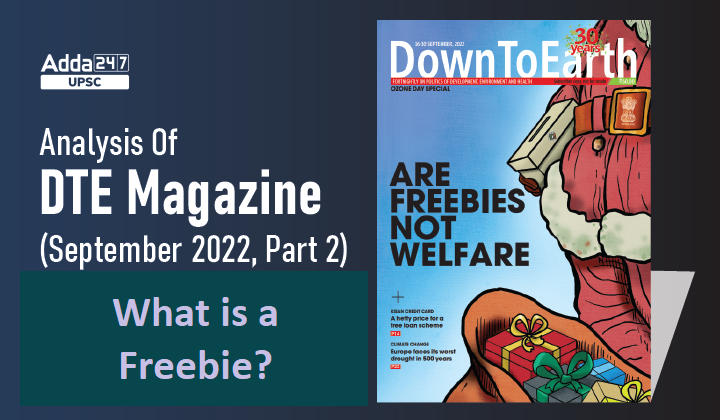Table of Contents
Down To Earth Magazine is a fortnightly magazine focusing on politics of environment and development, published in New Delhi, India.
UPSC Previous years’ questions on Development, Environment, Health and Disaster Management give us a clear idea about the increased importance of Down To Earth Magazine.
Down To Earth Magazine is one of the most important and indispensable sources for UPSC Civil Services Exam Preparation.
Keeping this in mind, here, we come with ”Gist Of Down To Earth Magazine” which covers important environmental current affairs articles in smooth pointed form, keeping in mind the demand of UPSC aspirants.
Introduction
- The country’s Supreme Court is tasked with deciding whether political parties should be restricted from promising freebies in election campaigns and manifestos.
- Regional parties have argued at the apex court that the promises politicians make are not freebies but for welfare, a constitutional duty of the government.
- Many experts argue whether “freebies” should even be termed as free items or gifts, as the government fulfils its promises through the taxpayers’ money.
What is a Freebie?
- Usually, a government or a political party fulfils its promise to the electorate in two ways: (i) a subsidy, like foodgrains administered at a discounted rate through a public distribution scheme; or (ii) an outright free service or good, like public transport for women or laptops for students. Which one (or both) is a freebie?
- Etymologically, freebie comes from the word free and can refer to anything given without payment. A subsidy, though it does not have a statutory or legal definition, is recognised in economics as government support to lower cost of a good or service for the beneficiary.
- Clearly, the line between subsidy and freebie is blurred and can be misinterpreted.
The 15th Finance Commission on Freebies
- The 15th Finance Commission, in its report for 2021-26, has dealt with the issue of freebies.
- It found that many states stressed that the categorisation of schemes into populist and non-populist cannot be done objectively, as development requirements differ from state to state.
- Further, they argued that elected sovereign governments are accountable to the people of the state and they, rather than the Finance Commission, should have the prerogative of deciding the welfare schemes.
RBI on Freebies
- RBI in its bulletin titled “State Finances: A Risk Analysis” offers a tentative definition
- It says that it is necessary to distinguish freebies from public/merit goods, expenditure on which brings economic benefits, such as the public distribution system, employment guarantee schemes, and states’ support for education and health.
- On the other hand, provision of free electricity, free water, free public transportation, waiver of pending utility bills and farm loan waivers are often regarded as freebies.
- RBI convolutes the understanding of freebies by listing the following state government schemes, announced in the states’ respective budgets for 2022-23, as freebies:
- (i) Jharkhand’s Guruji Credit Card Scheme, which offers loans up to R10 lakh at a low interest rate without mortgage to students for pursuing higher education;
- (ii) Bihar’s “Sashakt Mahila, Saksham Mahila” programme under which the government has allocated R900 crore to give cash incentives to girls for completing senior secondary and graduation;
- (iii) Rajasthan’s financial assistance of R6,000 to mothers on birth of second child under the state’s Indira Gandhi Matritva Poshan Yojana;
- (iv) Andhra Pradesh’s allocation of R6,400 crore for reimbursement of outstanding bank loans of self help groups under the ysr Aasra scheme in its 2022-23 budget.
What is RBI’s Argument?
- The rbi bulletin terms freebies announced by states in 2022-23 a source of fiscal risk.
- It cites latest data from the Comptroller and Auditor General of India to show a rise in state governments’ expenditure on subsidies, which after contracting in 2019-20, grew 12.9 per cent in 2020-21 and 11.2 per cent in 2021-22.
- Similarly, share of subsidies in the total revenue expenditure by states rose from 7.8 per cent in 2019-20 to 8.2 per cent in 2021-22.
- In the last three years, Jharkhand, Kerala, Odisha, Telangana and Uttar Pradesh have recorded the maximum increase in expenditure on subsidies, the rbi report notes, while Gujarat, Punjab and Chhattisgarh have spent more than 10 per cent of their revenue expenditure on subsidies.
- Some freebies may benefit the poor if properly targeted with minimal leakages, but their advantages must be evaluated against the large fiscal costs and inefficiencies they cause by distorting prices and misallocating resources, it argues.
Conclusion
Data shows that political parties of all hues, at the Centre as well as states, have offered development support or schemes for specific population groups since the country’s first general elections but nowadays when inequality is minimised, they are misusing taxpayers’ money for their political mileage only. In this scenario, the Supreme Court should go with the long-term welfare of the country.



 TSPSC Group 1 Question Paper 2024, Downl...
TSPSC Group 1 Question Paper 2024, Downl...
 TSPSC Group 1 Answer key 2024 Out, Downl...
TSPSC Group 1 Answer key 2024 Out, Downl...
 UPSC Prelims 2024 Question Paper, Downlo...
UPSC Prelims 2024 Question Paper, Downlo...
